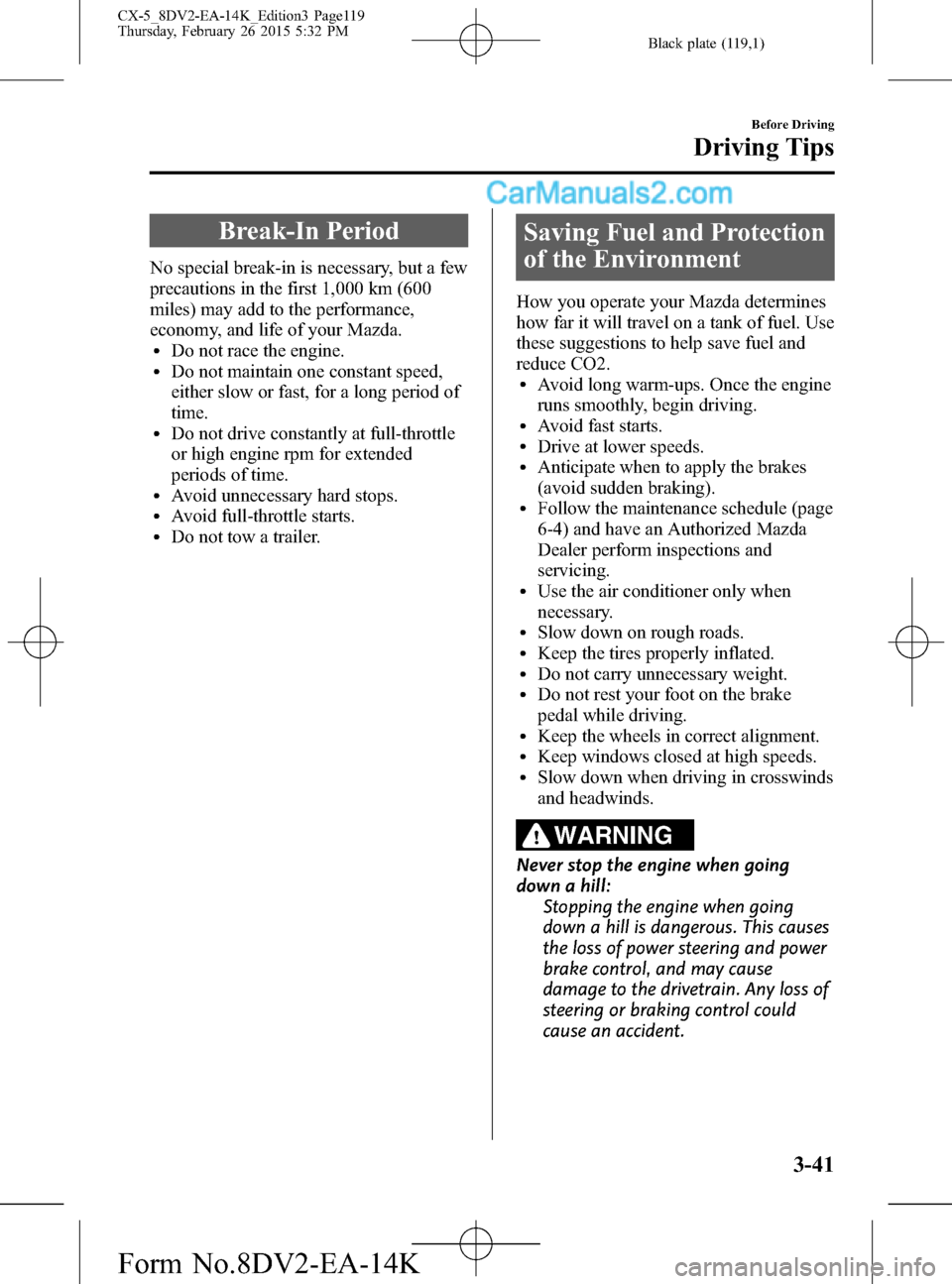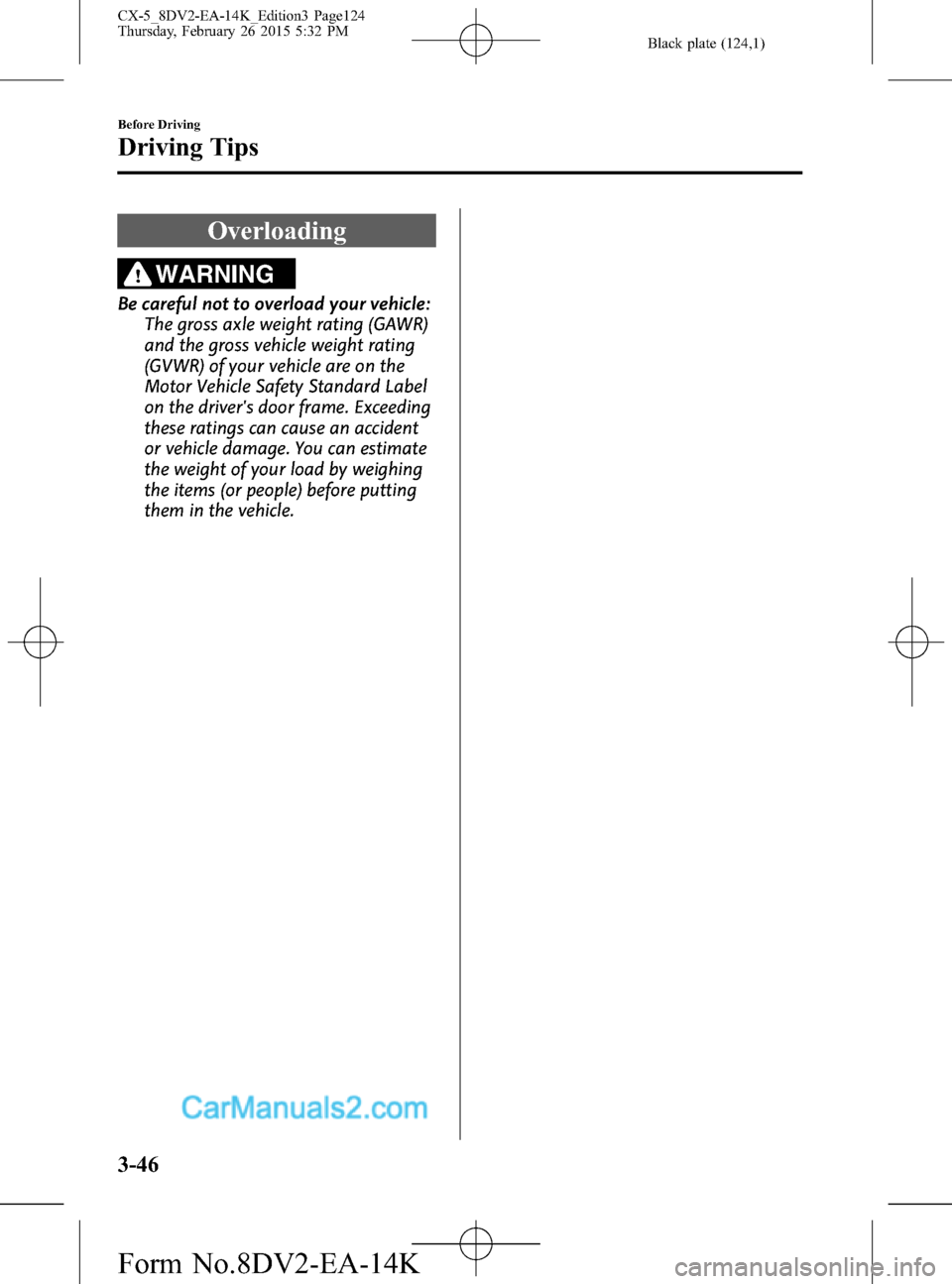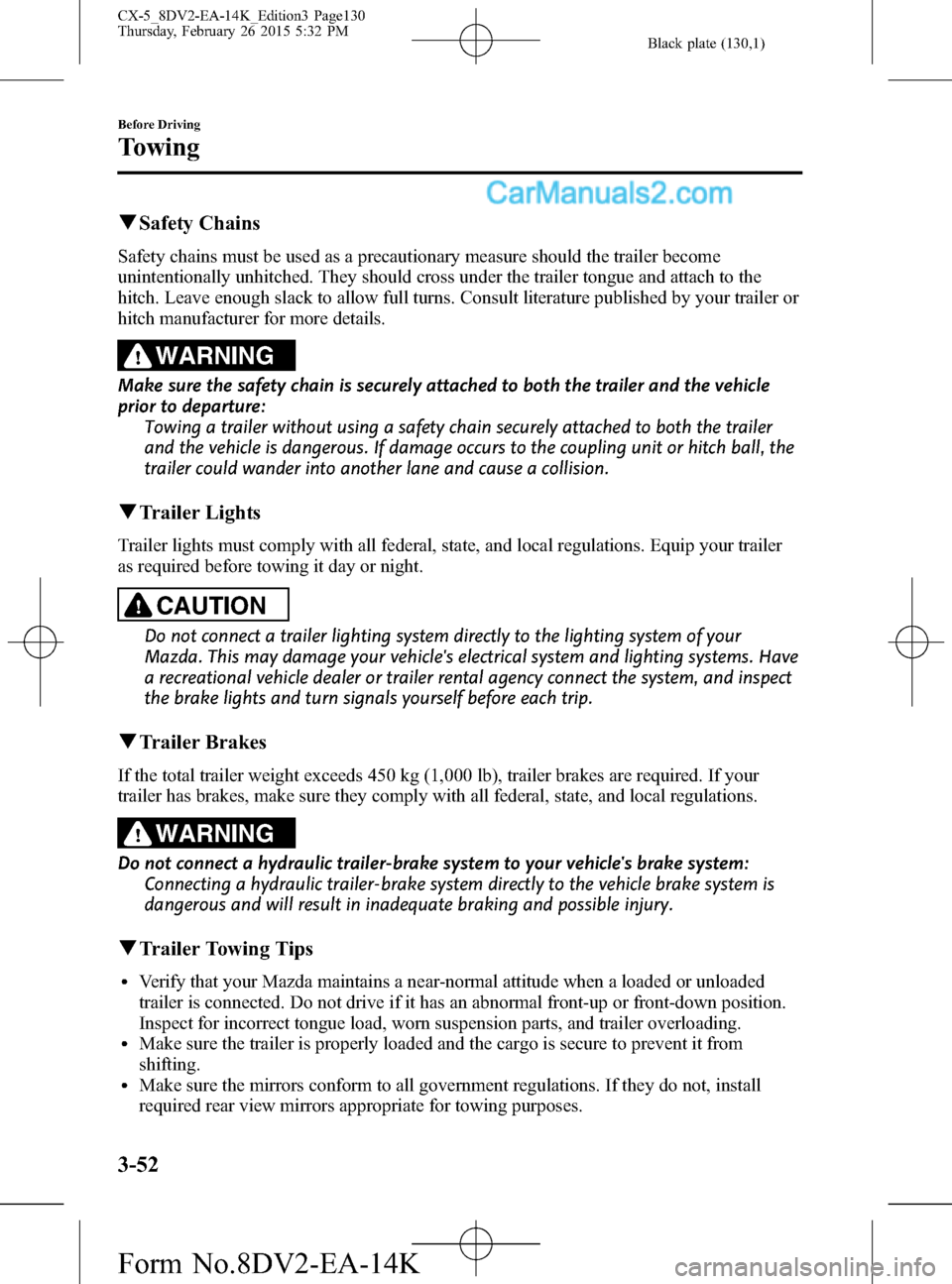weight MAZDA MODEL CX-5 2016 Owners Manual (in English)
[x] Cancel search | Manufacturer: MAZDA, Model Year: 2016, Model line: MODEL CX-5, Model: MAZDA MODEL CX-5 2016Pages: 626, PDF Size: 13.81 MB
Page 49 of 626

Black plate (49,1)
Do not allow a child or anyone to lean
over or against the side window of a
vehicle with side and curtain air bags:
It is dangerous to allow anyone to
lean over or against the side window,
the area of the front passenger seat,
the front and rear window pillars and
the roof edge along both sides from
which the side and curtain air bags
deploy, even if a child-restraint
system is used. The impact of
inflation from a side or curtain air
bag could cause serious injury or
death to an out of position child.
Furthermore, leaning over or against
the front door could block the side
and curtain air bags and eliminate
the advantages of supplemental
protection. With the front air bag and
the additional side air bag that
comes out of the front seat, the rear
seat is always a better location for
children. Take special care not to
allow a child to lean over or against
the side window, even if the child is
seated in a child-restraint system.
Front Passenger's Seat Child-Restraint
System Installation (With automatic
locking mode seat belt)
1. Make sure the ignition is switched off.2. Slide the seat as far back as possible.
3.(Vehicles with height adjustment on
front passenger's seat)
Adjust the seat bottom to the highest
position.
4. Place the child-restraint system on the
seat without putting your weight on the
seat and fasten the seat belt. See the
manufacturer's instructions on the
child-restraint system for belt routing
instructions.
5. To get the retractor into the automatic
locking mode, pull the shoulder belt
portion of the seat belt until the entire
length of the belt is out of the retractor.
6. Push the child-restraint system firmly
into the vehicle seat. Be sure the belt
retracts as snugly as possible. A
clicking noise from the retractor will be
heard during retraction if the system is
in automatic locking mode. If the belt
does not lock the seat down tight,
repeat the previous step and also this
one.
Essential Safety Equipment
Child Restraint
2-37
CX-5_8DV2-EA-14K_Edition3 Page49
Thursday, February 26 2015 5:31 PM
Form No.8DV2-EA-14K
Page 60 of 626

Black plate (60,1)
To prevent false detection by the air bag sensor system, heed the following:
ØDo not use tires or wheels other than those specified for your Mazda:
Use of any tire or wheel other than those specified for your Mazda (page 9-8) is
dangerous. Use of such wheels will prevent the vehicle's accident detections
system from accurately detecting a collision or roll-over accident resulting in
incorrect or unexpected air bag deployment and the possibility of serious injuries.
ØDo not overload your vehicle:
Overloading your vehicle is dangerous as it could prevent the air bag crash sensor
system from accurately detecting a collision or roll-over accident resulting in
incorrect or unexpected air bag deployment and the possibility of serious injuries.
The gross axle weight rating (GAWR) and the gross vehicle weight rating (GVWR)
for your vehicle are on the Motor Vehicle Safety Standard Label on the driver's
door frame. Do not exceed these ratings.
ØDo not drive the vehicle off-road:
Driving your Mazda off-road is dangerous because the vehicle has not been
designed to do so. Driving the vehicle off-road could prevent the air bag crash
sensor system from accurately detecting a collision or roll-over accident resulting
in incorrect or unexpected air bag deployment and the possibility of serious
injuries.
Do not modify a front door or leave any damage unrepaired. Always have an
Authorized Mazda Dealer inspect a damaged front door:
Modifying a front door or leaving any damage unrepaired is dangerous. Each front
door has a side crash sensor as a component of the supplemental restraint system. If
holes are drilled in a front door, a door speaker is left removed, or a damaged door is
left unrepaired, the sensor could be adversely affected causing it to not detect the
pressure of an impact correctly during a side collision. If a sensor does not detect a
side impact correctly, the side and curtain air bags and the front seat belt
pretensioner may not operate normally which could result in serious injury to
occupants.
Do not modify the supplemental restraint system:
Modifying the components or wiring of the supplemental restraint system is
dangerous. You could accidentally activate it or make it inoperable. Do not make
any modifications to the supplemental restraint system. This includes installing trim,
badges, or anything else over the air bag modules. It also includes installing extra
electrical equipment on or near system components or wiring. An Authorized Mazda
Dealer can provide the special care needed in the removal and installation of front
seats. It is important to protect the air bag wiring and connections to assure that the
bags do not accidentally deploy and that the seats retain an undamaged air bag
connection.
2-48
Essential Safety Equipment
SRS Air Bags
CX-5_8DV2-EA-14K_Edition3 Page60
Thursday, February 26 2015 5:31 PM
Form No.8DV2-EA-14K
Page 98 of 626

Black plate (98,1)
CAUTION
ØBefore opening the liftgate,
remove any snow and ice
accumulation on it. Otherwise, the
liftgate could close under the
weight of the snow and ice
resulting in injury.
ØBe careful when opening/closing
the liftgate during strong winds. If
a strong gust blows against the
liftgate, it could close suddenly
resulting in injury.
ØFully open the liftgate and make
sure that it stays open. If the
liftgate is only opened partially, it
could slam shut by vibration or
wind gusts resulting in injury.
ØWhen loading or unloading
luggage in the luggage
compartment, turn off the engine.
Otherwise, you could get burned
by the heat of the exhaust gas.
ØBe careful not to apply excessive
force to the damper stay on the
liftgate such as by putting your
hand on the stay. Otherwise, the
damper stay may bend and affect
the liftgate operation.
Damper stay
qOpening and Closing the Liftgate
Opening the liftgate with Electric
liftgate opener
Unlock the doors and liftgate, press the
electric liftgate opener on the liftgate, and
then raise the liftgate when the latch
releases.
Electric liftgate
opener
3-20
Before Driving
Doors and Locks
CX-5_8DV2-EA-14K_Edition3 Page98
Thursday, February 26 2015 5:32 PM
Form No.8DV2-EA-14K
Page 119 of 626

Black plate (119,1)
Break-In Period
No special break-in is necessary, but a few
precautions in the first 1,000 km (600
miles) may add to the performance,
economy, and life of your Mazda.
lDo not race the engine.lDo not maintain one constant speed,
either slow or fast, for a long period of
time.
lDo not drive constantly at full-throttle
or high engine rpm for extended
periods of time.
lAvoid unnecessary hard stops.lAvoid full-throttle starts.lDo not tow a trailer.
Saving Fuel and Protection
of the Environment
How you operate your Mazda determines
how far it will travel on a tank of fuel. Use
these suggestions to help save fuel and
reduce CO2.
lAvoid long warm-ups. Once the engine
runs smoothly, begin driving.
lAvoid fast starts.lDrive at lower speeds.lAnticipate when to apply the brakes
(avoid sudden braking).
lFollow the maintenance schedule (page
6-4) and have an Authorized Mazda
Dealer perform inspections and
servicing.
lUse the air conditioner only when
necessary.
lSlow down on rough roads.lKeep the tires properly inflated.lDo not carry unnecessary weight.lDo not rest your foot on the brake
pedal while driving.
lKeep the wheels in correct alignment.lKeep windows closed at high speeds.lSlow down when driving in crosswinds
and headwinds.
WARNING
Never stop the engine when going
down a hill:
Stopping the engine when going
down a hill is dangerous. This causes
the loss of power steering and power
brake control, and may cause
damage to the drivetrain. Any loss of
steering or braking control could
cause an accident.
Before Driving
Driving Tips
3-41
CX-5_8DV2-EA-14K_Edition3 Page119
Thursday, February 26 2015 5:32 PM
Form No.8DV2-EA-14K
Page 124 of 626

Black plate (124,1)
Overloading
WARNING
Be careful not to overload your vehicle:
The gross axle weight rating (GAWR)
and the gross vehicle weight rating
(GVWR) of your vehicle are on the
Motor Vehicle Safety Standard Label
on the driver's door frame. Exceeding
these ratings can cause an accident
or vehicle damage. You can estimate
the weight of your load by weighing
the items (or people) before putting
them in the vehicle.
3-46
Before Driving
Driving Tips
CX-5_8DV2-EA-14K_Edition3 Page124
Thursday, February 26 2015 5:32 PM
Form No.8DV2-EA-14K
Page 126 of 626

Black plate (126,1)
Trailer Towing (U.S.A. and Canada)
Your Mazda was designed and built primarily to carry passengers and cargo.
If you tow a trailer, follow these instructions because driver and passenger safety depends
on proper equipment and safe driving habits. Towing a trailer will affect handling, braking,
durability, performance, and fuel economy.
Never overload vehicle or trailer. Consult an Authorized Mazda Dealer if you need further
details.
CAUTION
Do not tow a trailer during the first 1,000 km (600 miles) of your new Mazda. If you
do, you may damage the engine, transaxle, differential, wheel bearings, and other
power train components.
qWeight Limits
TTW and GCWR
The total trailer weight (TTW), gross combination weight rating (GCWR), gross axle
weight rating (GAWR), trailer load, and trailer tongue load must be within the
prescribed limits.
lThe total trailer weight (TTW) is the sum of the weights of the trailer load (trailer
weight plus cargo), trailer hitch, 2 passengers, and vehicle load (baggage, food,
camp gear, etc.). Never allow the total trailer weight (TTW) to exceed specifications
in the Trailer Towing-Load Table.
lThe maximum GCWR is the combination weight of the trailer and load plus the
towing vehicle (including trailer hitch, vehicle passengers, and load). It must not
exceed specifications in the load table.
GAWR and GVWR
Do not exceed front and rear GAWR (gross axle weight rating) and GVWR (gross vehicle
weight rating). If you do, vehicle handling, braking, and performance will be affected.
These values are also on the Motor Vehicle Safety Certification Label posted on the driver's
door frame.
High-altitude operation
CAUTION
Be aware of the towing load weight differences when towing at high altitudes. For
altitudes exceeding 1,000 m, always reduce the towing load by 10% for every 1,000
m increase in altitude from the load indicated under the maximum GCWR heading in
the trailer towing-load table. If the determined maximum total towing load weight is
exceeded, the engine and other power train parts may be damaged.
3-48
Before Driving
Towing
CX-5_8DV2-EA-14K_Edition3 Page126
Thursday, February 26 2015 5:32 PM
Form No.8DV2-EA-14K
Page 127 of 626

Black plate (127,1)
TRAILER TOWING-LOAD TABLE
Because vehicle weights vary, adjustments must be made to meet the requirements in this
table.
ItemModel
SKYACTIV-G 2.0 SKYACTIV-G 2.5
2WD AWD 2WD AWD
Manual
transaxleAutomatic transaxle Automatic transaxle
MAX.
FRONTAL
AREA
2.97 m2(32 ft2)
MAX. TTW
907 kg (2,000 lb)
MAX. GCWR
2,620 kg
(5,776.0 lb)2,655 kg
(5,853.2 lb)2,723 kg
(6,003.1 lb)2,680 kg
(5,908.3 lb)2,751 kg
(6,064.8 lb)
MAX. GAWR
Front972 kg
(2,143 lb)1,009 kg
(2,224 lb)1,026 kg
(2,262 lb)1,035 kg
(2,282 lb)1,056 kg
(2,328 lb)
Rear971 kg
(2,141 lb)969 kg
(2,136 lb)1,020 kg
(2,249 lb)968 kg
(2,134 lb)1,018 kg
(2,244 lb)
MAX. GVWR
1,940 kg
(4,277 lb)1,975 kg
(4,354 lb)2,043 kg
(4,504 lb)2,000 kg
(4,409 lb)2,071 kg
(4,566 lb)
TRAILER-
TONGUE
LOADTongue load
Tongue load/Trailer load × 100 = 10 % to 15 %
Trailer load
DISTRIBU-
TION OF
TRAILER
LOADFront 60 %
Rear 40 %
Before Driving
Towing
3-49
CX-5_8DV2-EA-14K_Edition3 Page127
Thursday, February 26 2015 5:32 PM
Form No.8DV2-EA-14K
Page 128 of 626

Black plate (128,1)
WARNING
Always keep tow loads within specified limits as indicated in the Trailer Towing-Load
Table:
Attempting to tow loads greater than those specified is dangerous as it may cause
serious handling and performance problems that could result in personal injury or
vehicle damage, or both.
Load your trailer with the weight about 60 % toward the front and 40 % toward the
rear:
Loading the trailer with more weight in the rear than in the front is dangerous.
Doing so could cause you to lose control. The trailer tongue load must be 10 %―15
% of the total trailer load (sum of the weights of the trailer and cargo).
Always have the total trailer weight and tongue load determined prior to departure:
Attempting to tow loads without determining the total trailer weight and tongue
load is dangerous. Trailer sway from crosswinds, rough roads or other causes could
result in loss of control and a serious accident.
CAUTION
The total trailer weight and tongue load can be determined by weighing the trailer
on platform scales at a highway weight station or a trucking company.
qTrailer Hitch
Use only a hitch ball recommended by the trailer manufacturer that conforms to the gross
trailer weight requirement.
When not towing a trailer, remove the trailer hitch (if detachable) to reduce the possibility
of damage as a result of the vehicle being rear-ended.
3-50
Before Driving
Towing
CX-5_8DV2-EA-14K_Edition3 Page128
Thursday, February 26 2015 5:32 PM
Form No.8DV2-EA-14K
Page 130 of 626

Black plate (130,1)
qSafety Chains
Safety chains must be used as a precautionary measure should the trailer become
unintentionally unhitched. They should cross under the trailer tongue and attach to the
hitch. Leave enough slack to allow full turns. Consult literature published by your trailer or
hitch manufacturer for more details.
WARNING
Make sure the safety chain is securely attached to both the trailer and the vehicle
prior to departure:
Towing a trailer without using a safety chain securely attached to both the trailer
and the vehicle is dangerous. If damage occurs to the coupling unit or hitch ball, the
trailer could wander into another lane and cause a collision.
qTrailer Lights
Trailer lights must comply with all federal, state, and local regulations. Equip your trailer
as required before towing it day or night.
CAUTION
Do not connect a trailer lighting system directly to the lighting system of your
Mazda. This may damage your vehicle's electrical system and lighting systems. Have
a recreational vehicle dealer or trailer rental agency connect the system, and inspect
the brake lights and turn signals yourself before each trip.
qTrailer Brakes
If the total trailer weight exceeds 450 kg (1,000 lb), trailer brakes are required. If your
trailer has brakes, make sure they comply with all federal, state, and local regulations.
WARNING
Do not connect a hydraulic trailer-brake system to your vehicle's brake system:
Connecting a hydraulic trailer-brake system directly to the vehicle brake system is
dangerous and will result in inadequate braking and possible injury.
qTrailer Towing Tips
lVerify that your Mazda maintains a near-normal attitude when a loaded or unloaded
trailer is connected. Do not drive if it has an abnormal front-up or front-down position.
Inspect for incorrect tongue load, worn suspension parts, and trailer overloading.
lMake sure the trailer is properly loaded and the cargo is secure to prevent it from
shifting.
lMake sure the mirrors conform to all government regulations. If they do not, install
required rear view mirrors appropriate for towing purposes.
3-52
Before Driving
Towing
CX-5_8DV2-EA-14K_Edition3 Page130
Thursday, February 26 2015 5:32 PM
Form No.8DV2-EA-14K
Page 131 of 626

Black plate (131,1)
The three main causes of vehicle-trailer accidents are driver error, excessive speed, and
improper trailer loading.
Before driving
lHave your cooling and braking system checked by an Authorized Mazda Dealer.lBefore starting out, inspect the operation of all vehicle and trailer lights and all vehicle-
to-trailer connections. Stop and re-inspect all lights and connections after driving a short
distance.
Driving
lYour Mazda will handle differently with a trailer in tow, so practice turning, backing,
and stopping in a traffic-free area.
lTake time to get accustomed to the extra weight and length.lAllow more room between your vehicle and the one in front because braking distance
increases with a trailer. For each 16 km/h (10 mph) of speed, allow at least one vehicle
and trailer length between your Mazda and the vehicle ahead.
lAvoid jerky starts or sudden acceleration.lAvoid sudden braking. It may cause loss of control and result in jackknifing, especially
so on wet or slippery roads.
lShift the shift lever to the D position when towing a trailer in hilly terrain or when
heavily loaded.
The D position will allow operating the vehicle without frequent shifting.
Lane changes and turning
Avoid quick lane changes, sudden turns, and tight turns. Slow down before turning to
avoid the need of sudden braking.
A turning trailer will make a tighter arc than the tow vehicle. Compensate with turns that
are larger than normal.
Passing
Plan well ahead to pass other vehicles, and provide plenty of room before changing lanes.
Crosswinds from passing vehicles, especially larger ones, and the effects of rough roads
will affect handling.
If swaying occurs, firmly grip the steering wheel and reduce speed immediately, but
gradually.
Steer straight ahead. If no extreme correction of steering or braking is made, the
combination of less speed and firm steering will result in stability.
Backing up
Backing a vehicle with a trailer requires practice and patience. Back slowly, and have a
helper outside at the rear of the trailer to reduce the risk of an accident.
To turn the trailer, place your hand at the bottom of the steering wheel and turn it in the
direction you want the trailer to go. Make only slight movements to prevent sharp or
prolonged turning.
Before Driving
Towing
3-53
CX-5_8DV2-EA-14K_Edition3 Page131
Thursday, February 26 2015 5:32 PM
Form No.8DV2-EA-14K